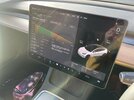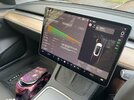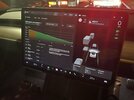Very interesting topic in this thread--I'm still trying to learn more! Here are my stats:
- 2022 M3 LR, 11 months old with 8,058 miles
- I've maintained an avg SOC of about 40% with an avg temp of 60F
- I almost always set a limit of 50% when charging at home, never used a Supercharger
- Battery health (via Teslogic app) shows 8.2% degradation
From what I've read here in this thread, I should expect a drop of about 2-3% due to calendar aging during this first year and a little bit from cycle loss. But it seems that I may be experiencing a fair amount more than this, particularly given my average SOC and charging habits.
Well, I know I will ’get some’ for saying this

but in all research the cyclic and calendar aging is very predictable.
Even if there is two batches tested, they behave the same despite having different capacity. The span of difference in calendar and cyclig aging in general is quite low.
There really shouldnt be much ”battery lottery” when it comes to real capacity.
The initial capacity seem to differ slightly but it might be the BMS algoritm maybe even more than the real difference in capacity.
New Jersey should mean that you have a Panasonic NCA chemistry battery.
The average battery temp will be higher than the average ambient temp, as the battery heats from driving and charging and also from having the car in the sun.
60F average might be 20C avegarge batt temp (15C + 5C for driving / charging/ heating in the sun). That difference doesnt change it much, just telling for the sake of doing better calculations for other people reading.
If your car is 11 months since you did get it, we could calculate about one year from start of calendar aging?
2.5-3% seems like a fair number.
If the average SOC is correct (most important more or less no time over 55-60%), and the temperature is correctly estimated, Id say your degradation should be around that point.
I do not know how good stats is (if that’s what you use) to calculate degradation.
To begin with, 75.6/82.1 = 7.9%.
The 8.2% calculation is not correctly calculated. This at least put my attention to the professionalism of the program you use.
Next thing, more or less no Model 3 with the 82.1kWh pack show even close to 82.1 kWh new.
My pack topped 81.6 kWh Nomimal Full pack and 82.0 kWh Nominal Remaining.
Most packs on M3P did not go above 81 kWh, I think. 80-81kWh is more average.
Also, I do not know if the M3LR has lower average (like if the M3P did get “selected/matched packs).
It would be more fare to use your starting value. Also, I can not se your present range.
Do you have a graph over the range from new until today?
I would suspect that the BMS could be a bit off, and underestimate the capacity.
I have an average batt temp of 13C and average SOC of 43% or so. (Im at work but have logged data of both SOC and temp down to hundreds of a percent and degrees.
10C will keep the calendar aging at about 80% of the 25C graphs, so 2 years and 2 months from the manufacturing date set my battery at:
(0.8x2.5) x (square root (26/10)) = 3.2%.
3.2% down from 82 = 79.3 kWh.
I have mostly small cycles at low SOC but some 25-30 full charges and 45 Supercharging sessions. So maybe 1-2% cyclic aging. If 1.5% the battery would be at 78.1 kWh today.
The NFP has been around 79 kWh lately but was at 78.2 kWh yesterday.
My NFP was at 81 kWh for a very long time when my calculation said that the capacity should be around 79 kWh.(at this time I also did a 100-0% drive that showed that the capacity actually was 79 kWh)
That is 2.5% above ”the real value”. The BMS was clearly off by 2.5% above.
About at this time my range started dropping, and the lowest NFP I saw was 75,7 kWh.
That is 4% below the true capacity!!!
So in a quite short time I both saw a 2.5% overestimate and a 4% underestimation.
The BMS is back on track, or at least not very far away.
The take away is that my calculation is in line with the tested capacity from the 100-0% drive, so for me the prediction is correct. And it should be this for you as well.
I would guess you havent lost more than your 2.5-3% from the initial true capacity and I guess your BMS is off, or the software you use is not right.
You might wanna do a “BMS calibration” to get the BMS to show the capacity more precise…in my case, I havent bothered as the calibration with different SOC’s etc actually does not increase the real range, instead it decreases it slightly by increasing average SOV and introduces bigger cycles.
Not a problem at all but the only thing it is good for is the owners feeling.
It would be nice to see a graph of the range from new to now.
Also, a full charge from low SOC might better show what range the car really think it has.
I'm not freaking out, just interested in hearing people's thoughts on my situation. Thanks!





